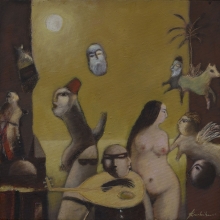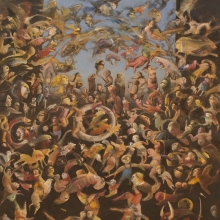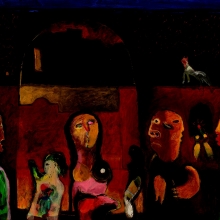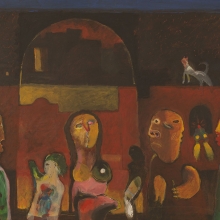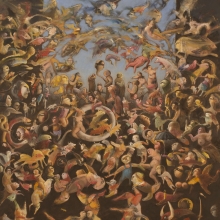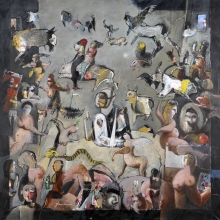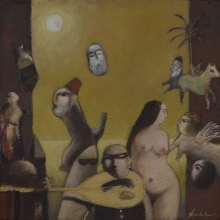Halim KARABIBENE (Bizerte - Tunisia, 1962).
Lives and works between Bizerte and Berlin.
Karabibene’s works beautifully illustrate the alarming dream approach of reaching another dimension through the framework of aesthetics in the artwork. art, which is constantly changing, stimulates our unconscious, through lyric. Halim Karabibene came to recognition in the 1990s due to his unusually sarcastic yet masterfully executed collages and oneiric paintings. Throughout his career, Karabibene has formally explored an alternative universe, one that is hybrid and playfully “staged” with a whole range of mythical neo pop characters.
Since 2007, Karabibene has been pursuing a multidisciplinary performance in which he has been encouraging public authorities to inaugurate Tunisia’s first National Museum of Modern and contemporary Art (MNAMC). With a pressure cooker as symbol and form of the future Museum, Karabibene uses social networks, events and exhibitions to effectively launch this pseudo fictional museum until it sees the light. Between 1982 and 1993, Karabibene has studied architecture and attended the École Nationale Supérieure des Beaux-Arts in Paris. From 1999 to 2001, he lived at the Cité Internationale des Arts of Paris.
Represented by Elmarsa gallery, Halim’s work has been widely exhibited in private institutions and museums around the world, including at the ifa gallery Berlin and Stuttgart, Barjeel Foundation in Sharjah, Museo Vittoriano in Rome, Institut du Monde Arabe in Paris, MAMA Algiers, Museo Pontevedra Spain etc. He has also made several short films and has won several awards such as the Faucon d’Or of the International Film Festival in Kelibia, Tunisia (1995) and the Trophée d’Or of the 12th Festival of Visual Art in Mahres, Tunisia. Meanwhile, he won a scholarship from the French Foreign Ministry in 1999. He has won twice a grant from the Tunisian Ministry of Culture, in addition to the Tunisian Ministry of Culture’s national award for creation in 2000, and the Tunisian Ministry of the Environment’s Prize in 2004.


